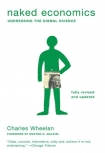Naked Economics by Wheelan, Charles (spanish books to read .txt) 📕

Read free book «Naked Economics by Wheelan, Charles (spanish books to read .txt) 📕» - read online or download for free at americanlibrarybooks.com
Read book online «Naked Economics by Wheelan, Charles (spanish books to read .txt) 📕». Author - Wheelan, Charles
Some doctors are willing to do battle with the insurance companies on behalf of their patients. Others simply break the rules by disguising treatments that are not covered by insurance as treatments that are. (Patients aren’t the only ones suffering from an asymmetry of information.) Politicians have jumped into the fray, too, demanding things like disclosure of the incentives paid to doctors by insurance companies and even a patient’s bill of rights.
The information problem at the heart of health care has not gone away: (1) The patient, who does not pay the bill, demands as much care as possible; (2) the doctor maximizes income and minimizes lawsuits by delivering as much care as possible; (3) the insurance company maximizes profits by paying for as little care as possible; (4) technology has introduced an array of massively expensive options, some of which are miracles and others of which are a waste of money; and (5) it is very costly for either the patient or the insurance company to prove the “right” course of treatment. In short, information makes health care different from the rest of the economy. When you walk into an electronics store to buy a big-screen TV, you can observe which picture looks clearest. You then compare price tags, knowing that the bill will arrive at your house eventually. In the end, you weigh the benefits of assorted televisions (whose quality you can observe) against the costs (that you will have to pay) and you pick one. Brain surgery really is different.
The fundamental challenge of health care reform is paying for the “right” treatment—the “product” that makes the most sense relative to what it costs. This is an exercise that consumers perform on their own everywhere else in the economy. Bean counters should not automatically say no to super-expensive treatments; some may be wonderfully effective and worth every penny. They should say no to expensive treatments that are not demonstrably better than less expensive options. They should also say no to doing some tests “just to be sure,” both because these diagnostics are expensive, but also because when administered to healthy people they tend to generate “false positives,” which can breed expensive, unnecessary, and potentially dangerous follow-up care.
There is an old aphorism in advertising: “I know I’m wasting half my money; I just wish I knew which half.” Health care is similar, and if the goal of health care reform is to restrain rapidly rising costs, then any policy change will have to focus on quality and outcomes rather than just paying for inputs. New York Times financial columnist David Leonhardt describes the treatment for prostate cancer (where fabulously expensive technology does not appear to be delivering better health) as his own “personal litmus test” for health care reform. He writes, “The prostate cancer test will determine whether President Obama and Congress put together a bill that begins to fix the fundamental problem with our medical system: the combination of soaring costs and mediocre results. If they don’t, the medical system will remain deeply troubled, no matter what other improvements they make.”
But we’re not done with health care yet. The doctor may know more about your health than you do, but you know more about your long-term health than your insurance company does. You may not be able to diagnose rare diseases, but you know whether or not you lead a healthy lifestyle, if certain diseases run in your family, if you are engaging in risky sexual behavior, if you are likely to become pregnant, etc. This information advantage has the potential to wreak havoc on the insurance market.
Insurance is about getting the numbers right. Some individuals require virtually no health care. Others may have chronic diseases that require hundreds of thousands of dollars of treatment. The insurance company makes a profit by determining the average cost of treatment for all of its policyholders and then charging slightly more. When Aetna writes a group policy for 20,000 fifty-year-old men, and the average cost of health care for a fifty-year-old man is $1,250 a year, then presumably the company can set the annual premium at $1,300 and make $50—on average—for each policy underwritten. Aetna will make money on some policies and lose money on others, but overall the company will come out ahead—if the numbers are right.
Is this example starting to look like the Hope Scholarships or the used-car market? It should. The $1,300 policy is a bad deal for the healthiest fifty-year-old men and a very good deal for the overweight smokers with a family history of heart disease. So, the healthiest men are most likely to opt out of the program; the sickest guys are most likely to opt in. As that happens, the population of men on which the original premium was based begins to change; on average, the remaining men are less healthy. The insurance company studies its new pool of middle-aged men and reckons that the annual premium must be raised to $1,800 in order to make a profit. Do you see where this is going?





Comments (0)